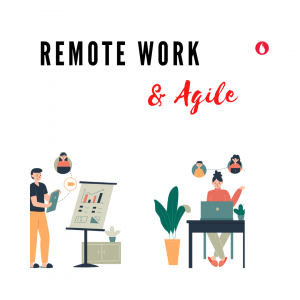Remote Agile
Odds are that you are reading this from the comfort of your homes, instead of the office.
Ever since the coronavirus struck the world, organizations across the world have embraced the work from home option. The fact that despite things returning to normal, a lot of organizations continue to work remotely, drops a hint on something brewing well with Remote Agile.
One of the four core values of the Agile manifestos is prioritizing “Individuals and Interactions over processes and tools”. Which clearly indicates the heavy weightage Agile practices give to being close knit and having face to face interactions. Wondering, why? An easy guess would be because working together promotes better bonding and faster decision making and hence higher productivity.
Is this promoted when working from home? Face to face interactions – Yes, could be. Thanks to webcams, provided they’re used by employees regularly. But close knit? – To each his own. Some employees continue to banter around and form camaraderie essential for a conducive work environment. But a lot of them always tend to be withdrawn and taciturn, limiting their inputs only to work related ideas. Given this postulation, it would be apt to conclude that the potential challenge with Remote Agile is not really the face to face interaction, but actually the Team Vibe.
It is a bit difficult to foster the community feeling while being in physically distant places. The consequences of which are misunderstandings and cultural differences that can hamper productivity.

“The most efficient and effective method of conveying information to and within a development team is face-to-face conversation.”
From Agile manifesto – principles
In addition to lack of team bonding, another key challenge is that of time difference. Given that most clients are international and in different time zones, urgent meetings and immediate calls are not easy. Due to short-period crossovers, it also gets difficult to press important topics timely and gather feedback over the same.
Now let’s take a look at how Agile can come to the rescue to tackle the above set of problems.
The Agile manifesto principle of being “open to change and using change for the customer’s advantage” comes in handy. Without batting an eyelid, one of the most evident changes that has hit the world in the last two years is the new normal we talk of – WFH.
Surely, Agile expects us to keep up this principle and make the best use of it. Periods of disruption, use of disruptive technologies and growing digitization are all well suited for Agile practices.
Conventionally agile practices have been used for teams which are put together in one location. But it looks like decentralized teams can also operate with equal effectiveness. Let’s take a look at some benefits of Remote Agile.
- Cost effective hiring – In a remote environment, there is a larger exposure. Companies can hire talent from distant areas at competitive prices. Often, this also reduces the overhead because hiring can be done with lower investment.
- Good documentation – Since all the processes have to be shared across various locations, they are appropriately documented in digitized format, increasing the transparency of tasks.
- Freedom to work – Overall, the remote teams have flexible work schedules since they are scattered across multiple locations. The members even have the freedom to take breaks whenever they want and this freedom leads to better productivity.
The proof lies in the pudding. Most organizations, including ours, have been doing impressively well with remote work. Scrum, the most commonly used Agile methodology, may have to be tailored here and there to suit the individual team’s requirement. For example, the duration of sprints may decrease. From the general 0 to 4 weeks, we might see more of 0 to 2 weeks, since the work is always changing and teams have less control over their increments.
This might in turn lead to a hybrid model. Scrum has a lot of rituals and with shorter durations it means more reviews, more retros, more planning and meetings. Some of the steps that teams could take to make the most out of the Scrum rituals are given below.
- Keep noting all the pain points and schedule the retro / review only when a considerable size is amassed on the whiteboard.
- Plan a fortnightly Fun activity – Online games like Pictionary or Identifying personalities could lead to some good laughs and reveal fun sides of your teammates that you never knew of.
- Select a day of the week to be meeting free like “No Meeting Friday”. Unless and until absolutely necessary, one day of the week without meetings could be a cathartic experience and charge the team up for the next day’s meetings.
- Include a specific section for shoutouts during the retros – Nothing works like the boost of appreciations and acknowledgements. Retrospective meetings bring everyone together and are the best place to openly encourage teammates.
- Feel free to experiment and use what suits best among a range of whiteboard collab tools like Figma, Retrium or EasyRetro.
Even in a post-pandemic world of remote work, Agile can help you succeed both personally and professionally. While it may not look like it, Agile is even more valid and important today because the modern world requires us to be calm and collected during turbulent times, while still performing our best. It may look as if we’re independently working from home behind our laptops, but we’re not. We’re all in this together, and this is where Agile can step in and remind us of the concept of teamwork where it may have been forgotten, and empower us to continue chugging on.

